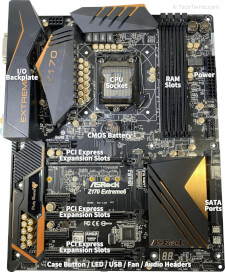Motherboard
A motherboard, also known as a "mainboard" or "logic board," is the primary circuit board in a computer that connects and controls the rest of its components. Every other piece of hardware in a computer ultimately connects to the motherboard, which serves as a hub that provides a path for the components to communicate with each other.
A computer's motherboard includes several important components, like the computer's UEFI (or BIOS in older systems). This special ROM chip contains instructions used during system startup and other configuration settings. Motherboards also provide the slots and sockets for installing the CPU, RAM modules, and PCI Express expansion cards.
Motherboards include integrated controller chips for networking, sound, USB, and data storage. They also provide the physical connections for these controllers, like USB ports, Ethernet ports, SATA ports, and M.2 slots. Motherboards provide data buses between these components to communicate back and forth. They also deliver the electricity from the computer's power supply to these internal components.
Computer motherboards come in a few standard form factors, ensuring that any standard-size motherboard fits in a corresponding computer case. These standards specify the placement of mounting screw holes, the location of expansion slots and I/O ports, the type of power supply, and the connection with the case's buttons and ports. The full-size ATX standard, and the smaller microATX variant, are the two most common.
NOTE: The chipsets built into a motherboard typically only support a specific series of CPUs. When CPU makers design a new series of processors, they also design the chipsets to support that processor's new features. This means that upgrading a computer's CPU generally requires a new motherboard as well.
 Test Your Knowledge
Test Your Knowledge